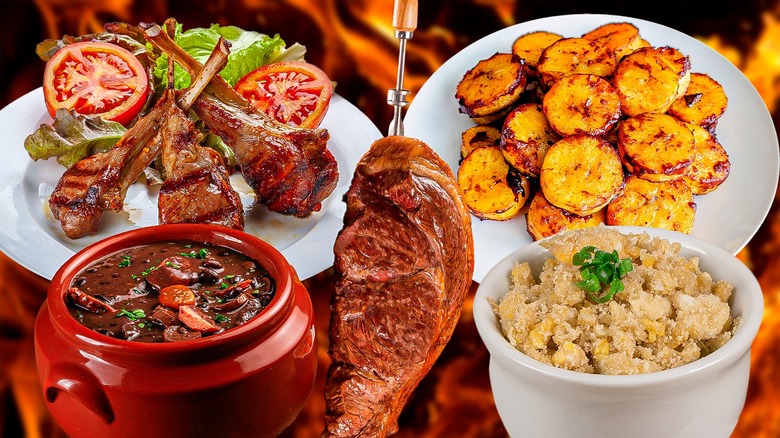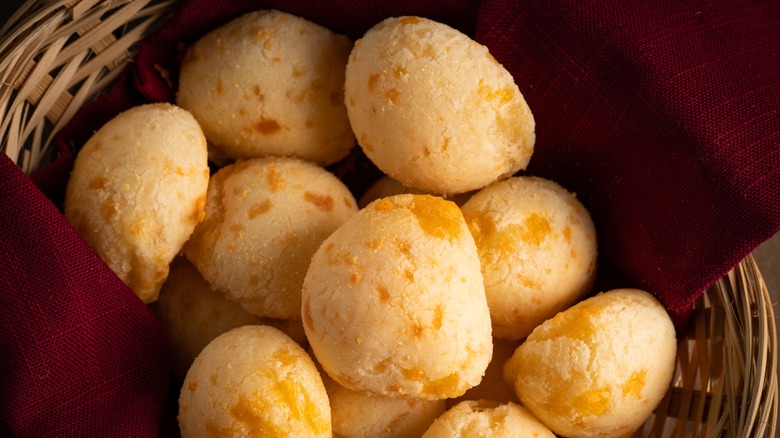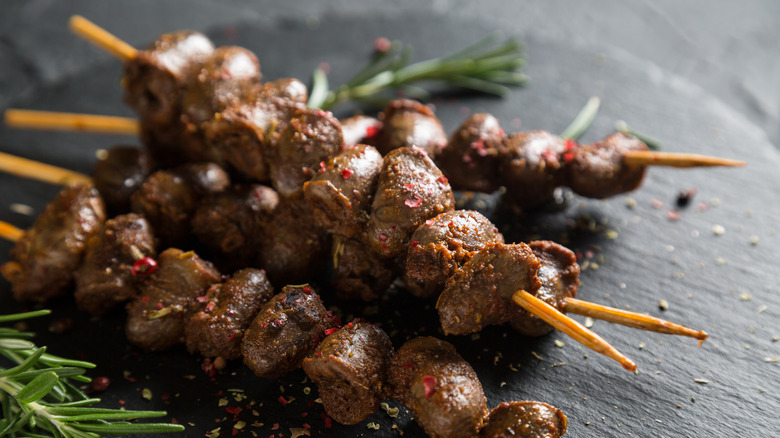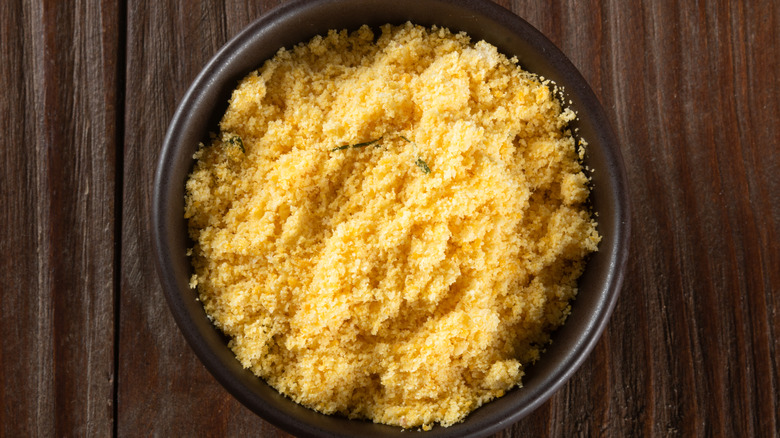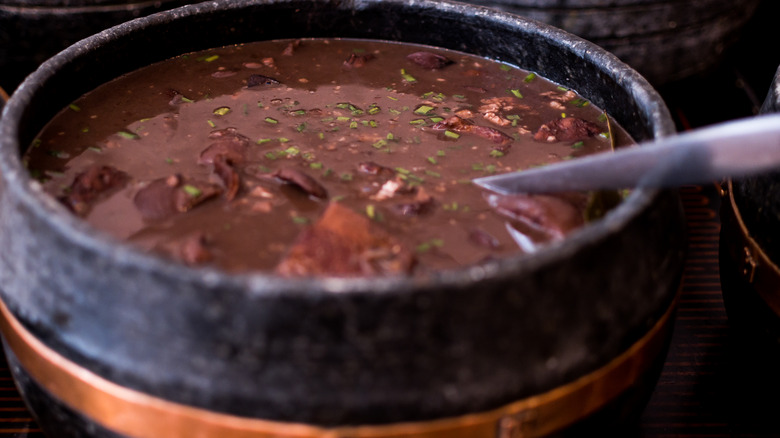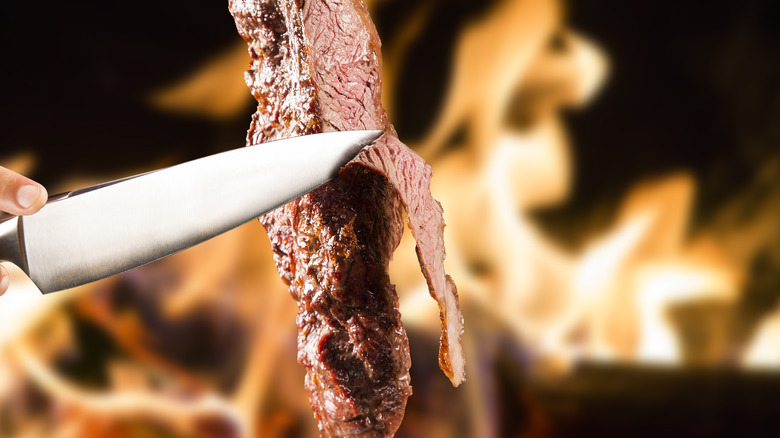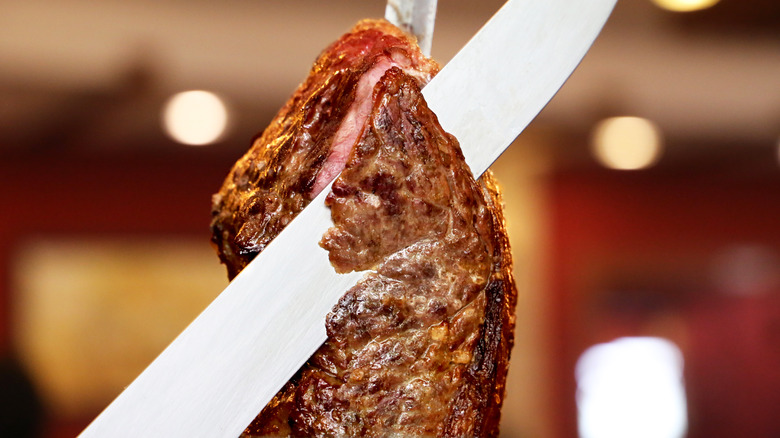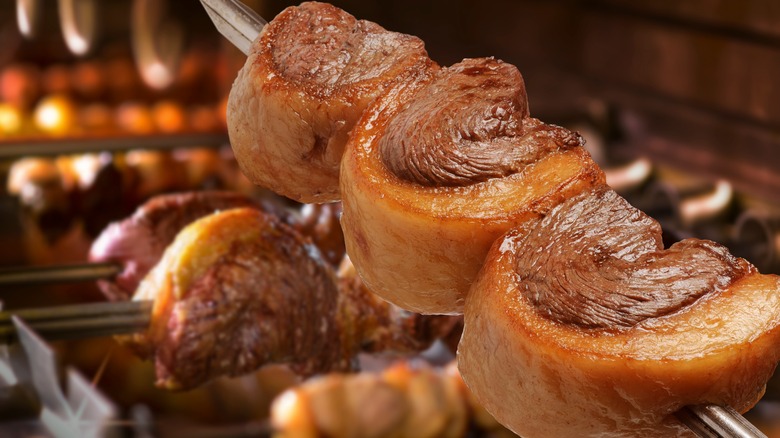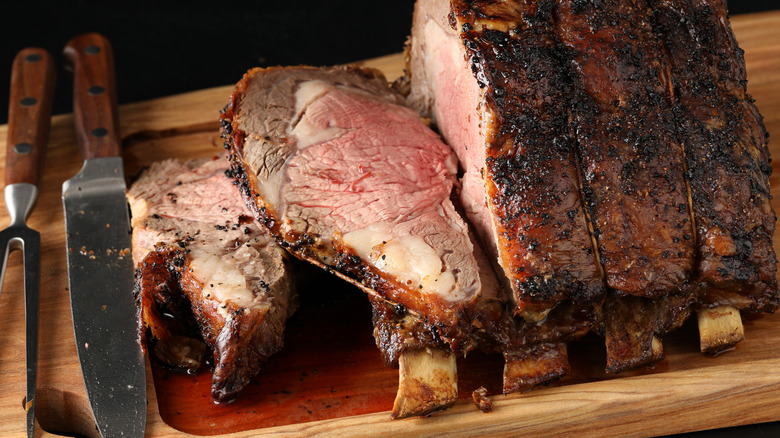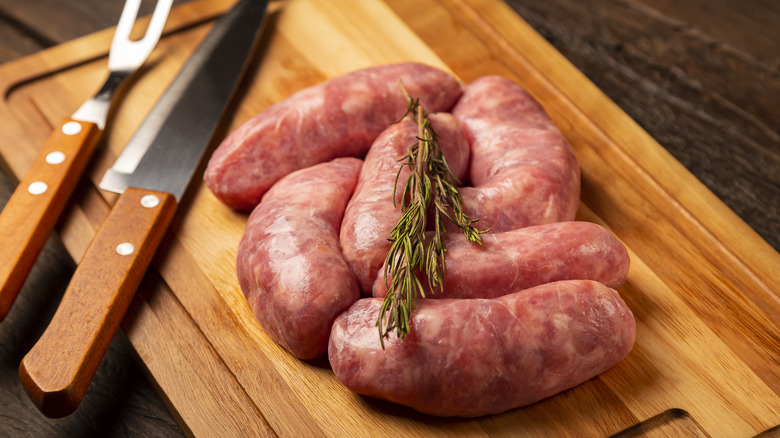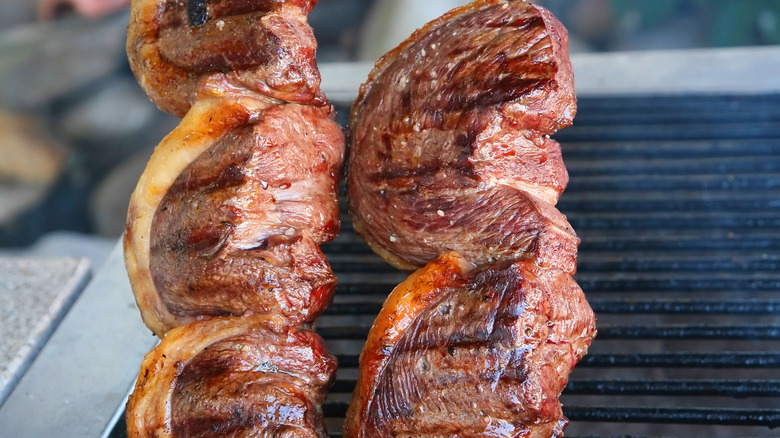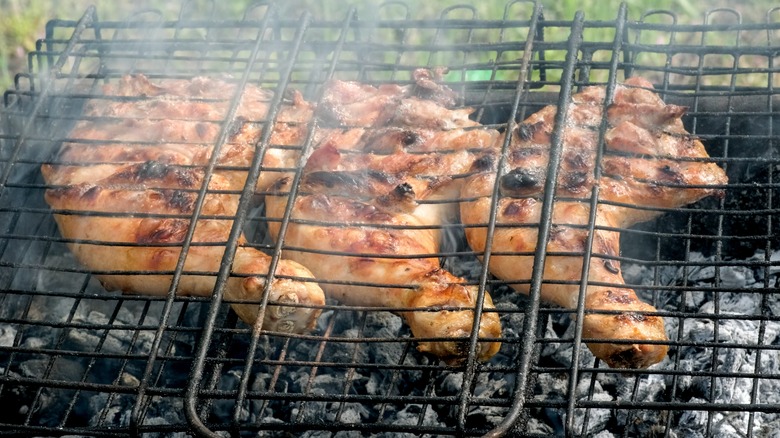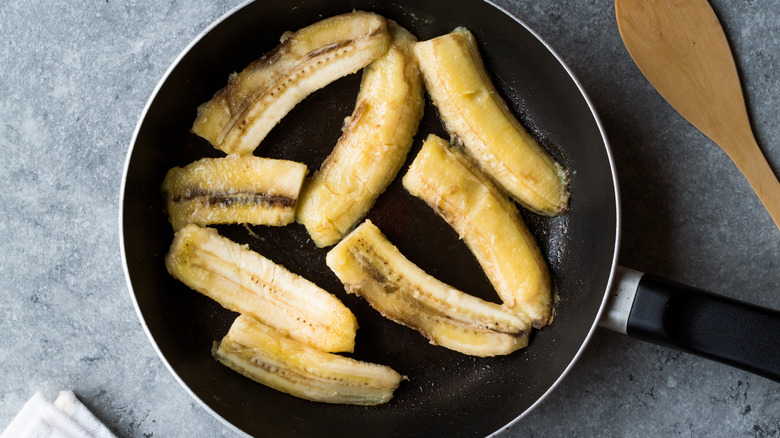12 Dishes You Need To Try At A Brazilian Steakhouse
Diners new to the Brazilian churrascaria experience, be forewarned: It's a far cry from your typical American steakhouse, where only appetizers are passed, and guest orders their own entrees. Instead, Brazilian steakhouses are akin to full-service all-you-can-eat buffets. Servers called gauchos walk past your table brandishing long, thin knives while carrying skewers of meat for slicing tableside. Rather than asking for more food, much like a game of poker, cards are placed on the table to indicate whether or not you're in for a given hand. Green means go, and red — well, perhaps you filled up on too much pão de queijo.
Named after the style in which the meat is prepared, a churrascaria is a steakhouse that serves meats cooked over an open flame. Invented in the 16th century by men traveling on horseback with easy access to cattle and open fire, the churrascaria is known for its characteristic grilling style, similar to kebab. Like with any steakhouse, it's imperative you arrive hungry, as dishes are served in rapid-fire succession.
I've visited churrascarias while traveling around Rio de Janeiro, and with that, grown aware of a way of dining that can be both theatrical and communal. Since then, I've dined at restaurants across the country in search of the best dishes to try to get the most out of any churrascaria experience. The secret to tasting some of the best Brazilian cuisine has to offer? Choosing wisely — and pacing yourself.
Pão de queijo
Filling up on the bread basket is a common mistake when dining out. But nowhere is this more problematic than at a Brazilian steakhouse, where maintaining your appetite is key to making it through to dessert. Brazilian steakhouses offer their own starchy temptation in pão de queijo, a lighter-than-air alternative to the Parkerhouse roll. But don't confuse these pillowy balls for bread rolls. Pão de queijo is made from tapioca flour, the starchy pulp of the cassava root, which has been a staple in Brazil since before Portuguese colonization. Tapioca flour, which is starchier and more finely ground than wheat flour, gives the bread a delicate, elastic texture.
Along with the tapioca flour, egg, fat (typically lard), and cheese are mixed into the dough to add richness. Many different cheeses are used to season pão de queijo, traditionally queijo de Minas, a mild variety originating from the state of Minas Gerais that's similar in flavor to Monterey Jack. Since they're made without wheat, pão de queijo are naturally gluten-free. In Brazil, it's common to find these served in street stalls as a light, inexpensive snack for those on the go. Because they're so small and savory, they're notoriously addictive but go slow — it would be foolish to fill up this early.
Coração de galinha
One of the first cuts offered in the rodizio, or "rotation" of meats, isn't a "cut" in the traditional sense. Relatively affordable, coração de galinha, or chicken hearts, is a common churrascaria appetizer and popular street food in Brazil. The hearts are marinated in a mixture of garlic, salt, pepper, and acid before they're threaded onto skewers and grilled. For a regional flair, they can be tenderized in cachaça, the popular Brazilian spirit made from fermented sugarcane juice.
Outside of Brazil, and Japan, where this offal is served grilled and skewered as yakitori, there isn't a strong demand for chicken hearts. But nationwide, it's a commonly requested appetizer. Brazilians living in the southern region of the country, which comprises Rio de Janeiro and Sao Paolo, eat about 2.4 billion pounds a year. Domestic consumption is so high that the heart of the chicken is the only part of the bird that Brazil can't meet the demand for exportation. It can take up to one hundred birds to provide enough hearts to make three average-sized churrascaria skewers of coração de galinha. Like other tougher cuts, the heart's rich, deep flavor comes from the organ working nonstop. Brazilians consider chicken hearts to be a delicacy, adding variety and complexity to an otherwise meat-forward menu.
Farofa
Many cuisines have devised a way to add texture to a dish without requiring expensive or hard-to-find ingredients. For Brazilians, it's the popular side dish and garnish farofa, used to add texture, salinity, and a pop of umami to beans, grilled meats, and vegetables. And like breadcrumbs, it's also used as a stuffing for poultry.
Farofa is made with coarse flour from the cassava plant (which in Brazil is referred to as manioc or manioc flour). You may be more familiar with its finely milled cousin, tapioca flour, which is used for baking pão de queijo. Like pão de queijo, farofa is gluten free. The simplest recipe for farofa starts by toasting coarse manioc flour in fat — typically lard or butter — until it takes on a strong, nutty flavor. As the manioc flour toasts in the hot fat, it begins to clump, resembling fine bread crumbs. More complex recipes call for small amounts of smoked or cured meat and, occasionally, offal for a stronger flavor. Other additions, like golden raisins, onions, and olives, jazz up a vegetarian-friendly version of the dish. Though farofa is flavorful, even in its simplicity, its genius lies in its ability to add textural contrast to any dish it garnishes.
Feijoada
Smoky, creamy, and mild, feijoada (pronounced fay-JWAH-dah) is a simple stewed black bean dish thickened with manioc flour. The dish is so integral to Brazilian cuisine that it's considered a national dish. The name feijoada is derived from feijao, the Portuguese word for bean. Modern interpretations of this dish typically add cured or smoked pork, like sausage or bacon, to give the stew depth, whereas more traditional recipes might call for pork off-cuts, like feet, ears, and even pigtails. Farofa is commonly served alongside for texture. It wouldn't be odd to compare feijoada to the French cassoulet, in both aesthetics and taste, for the black beans' inherent smokiness, use of pork products, and comforting yet stick-to-your-ribs character.
There isn't a conclusive answer to the question of how the dish originated. Some speculate that enslaved Brazilians came up with the dish as a means of stretching offal. Other theories explain it as a dish brought over by Portuguese colonizers using more sought-after cuts of pork — much like cassoulet. In the churrascaria, you may eat this humble dish as part of a leisurely meal. Saturdays are considered the "day of feijoada," when many households will cook the dish in the afternoon to enjoy with good company. Though it's necessary to try a few spoonfuls, feijoada is filling and can spoil your appetite if you're not careful.
Fraldihna
Coming from the bottom sirloin of the cow, fraldihna is a desirable cut that doesn't have quite the cache of picanha, making it a perfect way to ease into the selection of beef at a Brazilian steakhouse. The bottom sirloin is located between the hind leg and the bottom tips of the ribcage. You may be most familiar with this cut as flank steak, which comes from the same region. At a churrascaria, fraldihna is skewered as one single length and rotated on a spit until the meat forms a tantalizing crust and the interior is sufficiently smoky and medium-rare. Gauchos shave this cut into long, thin ribbons against the grain for maximum tenderness.
Fraldinha, like other classic churrascaria cuts, is cooked as slowly as possible over an open flame. The bottom sirloin is a muscle that's worked hard, so the resulting meat is exceptionally flavorful. But if not prepared correctly, it can become tough. The upside of such a heavily worked part of the cow is that fat has a chance to work its way into the muscle fibers, making fraldinha a well-marbled choice. As the meat rotates on its spit, the marbling slowly melts, basting it cut from the inside out.
Alcatra
For a more tender, lean cut of beef, don't miss alcaltra, also known as top sirloin. Likely one of the larger cuts of meat to grace your table, alcatra comes from the back of the cow that's lauded for its juiciness, buttery texture, and big, beefy flavor. "Alcaltra completa" refers to both the top and bottom sirloin, which can be broken down further into several other cuts (including picanha). Alcatra completa is one of the longest muscles on the cow, ranging from two to three feet in length.
Rarely will you find this cut served whole in the United States. Instead, you'll find it portioned further into sirloin steaks. The steak is skewered as a single piece, with only a small portion of the fat cap left intact. After it's grilled, the meat is shaved thinly with or against the grain. Despite it being a particularly tender cut of beef, in Brazilian homes, this cut's namesake, "alcatra," also refers to a popular Azorean dish of braised beef chuck with vegetables, considered to be Portuguese-style pot roast.
Picanha
Dining at a Brazilian steakhouse is a marathon, not a sprint, and the number of dishes served may feel endless. Regulars will tell you that each cut is served from least to most premium — a trick to outsmart your appetite, so you'll want to make sure to pace yourself accordingly. One such premium cut is the picanha, a variety of beef similar to sirloin that comes from the rump of the cow. To prepare picanha, the rump is cut along the grain into half-inch thick pieces before being grilled and served perfectly mid-rare. Gauchos will go the extra step of cutting each piece again tableside against the grain to ensure maximum tenderness.
Though the meat itself is lean, the picanha is one of the most flavorful, satisfying cuts to eat. These crescent-shaped portions of beef are lauded for their thick, crackling fat cap. American butchery styles break this cut down into other sub-cuts, sacrificing the fat cap; Brazilian-style butchery keeps the cap intact, which allows the fat to gently baste the meat as it grills, leaving each bite with a bit of extra unctuousness to enjoy. And because the rump is not an overly used muscle, the picanha remains mouthwateringly tender and juicy after grilling.
Costela
When costela, or beef ribs, arrive at your table, you might be tempted to flip your card red. Their staggering size will either appease or intimidate those new to churrascaria. But the giant pre-historic-looking beef ribs are not to be missed. Costela do dianteiro (chuck ribs) or costela minga (short ribs) come from the meaty back region of the cow. These ribs are more steak-like than spare ribs, and it's their meaty nature that allows them to be skewered and cooked on a spit. Because they're so full, they stay juicy and tender despite the high degree of heat and smoking typical of churrasco-style cooking.
Costela is prepared impossibly simply — just a generous sprinkling of coarse salt and pepper is all you need to season this inherently flavorful cut. You'll find two common cooking methods for costela: The first, "no bafo," starts by wrapping the ribs in cellophane paper before roasting them in a barbecue pit. The second, "fogo de chao," is the skewered preparation more common to a churrascaria. As James Hills, author of the food and travel blog Mantripping, told Mashed, enjoying costela in rodizio is a boon to diners of all appetites looking to try just a taste of this incredibly rich and fatty cut without going overboard. Outside of barbecue, this cut is served shredded in Brazilian cuisine and used much like you would pulled pork: as a topping for sandwiches, as a filling, or in soups.
Linguiça
After seemingly endless cuts of beef, spicy, succulent pork sausage will feel like a welcome reprieve. One such sausage you'll find served at every Brazilian steakhouse is linguiça (pronounced lin-GWEE-ka). Though it's named after the word lingua, which means tongue in Portuguese, linguiça doesn't contain tongue at all — great for squeamish palates — instead earning its name from its uniquely long and slender appearance. Linguiça is traditionally prepared with ground pork butt, a tougher cut that comes from the shoulder of the pig best enjoyed when ground — as is the case with linguiça — or subjected to longer, slower cooking methods like stewing or braising.
Linguiça is are often confused for chorizo, but the sausage is of Portuguese, not Spanish origin. It is similarly flavored, with garlic, oregano, cumin, and a variety of sweet paprika that tinges the pork's juices saffron-red. Unique to linguiça is the salt and vinegar brine that some chefs add to the grind, which gives this sausage added flavor and tenderness while mellowing out its spice level. Occasionally the sausage is left whole and brined directly in its casing before being smoked and grilled. In Brazil, you'll find linguiça sliced and piled onto a roll with a hearty drizzle of chimichurri for a quick lunch option. However, at a churrascaria, linguiça is served coiled, skewered, and sliced on the bias like flank steak; or, occasionally, formed into smaller links when raw before being grilled and served in whole pieces.
Picanha de cordeiro
Though you can find other lamb-based dishes, like chops, at Brazilian steakhouses, one dish you won't want to miss out on is picanha de cordeiro, or lamb picanha. Those who are fans of juicy beef picanha, with its succulent meat and friable fat cap, are in for a treat. It's a well-known cooking fact that fat molecules trap flavor. Because of this cut's higher fat content, expect a more pungent gaminess to come through (the result of the lamb grazing on pasture) than you'll find in lamb chops.
To prepare picanha de cordeiro for slow roasting, a leg of a lamb is boned out. Once the rump bone is removed, the remaining rump meat is trimmed. The uppermost portion of the leg is considered the picanha, the meatiest, fattiest part of the leg. Like beef picanha, the fat cap is left intact before the meat is threaded onto skewers in a U-shape and cooked over an open flame. Expect a slightly thicker slice from your gaucho due to this cut's relatively smaller stature compared to beef.
Frango churrasco
Frango churrasco is one of the few chicken dishes on a menu otherwise dominated by pork and beef. Frango churrasco simply translates to "barbecue chicken" (frango meaning chicken in Portuguese). Less adventurous palates will enjoy its straightforward preparation, but it also stands out among the many dishes at Brazilian steakhouses, which are seasoned only with salt and pepper. Whole butterflied chicken is marinated in a spicy piri-piri style dressing with origins in South Africa and Portugal. Leg quarters or thighs may also be used in place of a whole butterflied chicken and skewered directly.
Garlic, hot pepper, and acid (lemon juice or vinegar) are used in the marinade to tenderize and flavor the meat. If you're spice-averse, you may consider checking with your gaucho before digging in: The longer the chicken sits in the marinade, the hotter it becomes. The meat is then seasoned liberally with coarse salt before being sandwiched between two grilled grates and rotated slowly over a fire. The chicken is basted with sauce as the meat turns for additional heat and flavor.
Banana frita no açúca
It may seem odd to find caramelized bananas on a steakhouse menu, but the key to a great meal is balancing flavor and texture. This sweet, creamy dish does just that. Brazilian steakhouse recipes for the dish may start with rolling whole bananas in melted butter, followed by cinnamon and sugar, before shallow frying until all sides are golden. The exterior is molten, while the center of each banana maintains its structure. Gooey on the outside and soft on the inside, they lend sweetness to an otherwise umami-rich meal, while the caramelized exterior heightens the subtleties of the sweetness of the crust on the meat.
In Brazilian cuisine, bananas have been enjoyed as a starchy side ever since the first crop made its way to the mainland in the 15th and 16th centuries by Portuguese sailors. While underripe bananas reminiscent of green plantains may seem like a more intuitive choice here, it's the sweet bananas that are used as a foil for smoky, rich churrasco.
Static Media owns and operates Tasting Table and Mashed.
